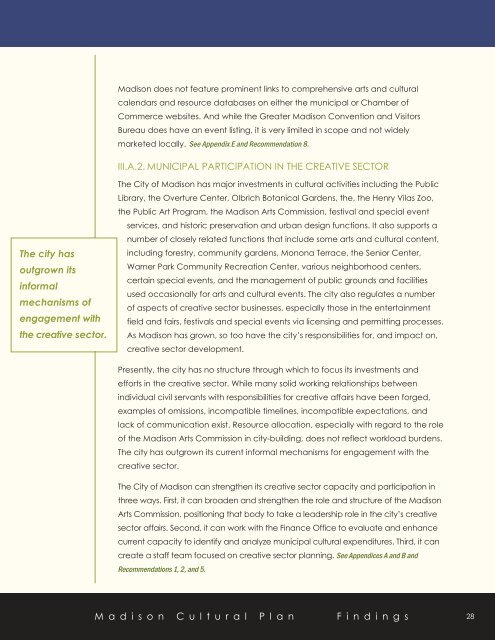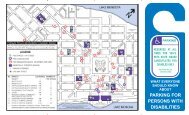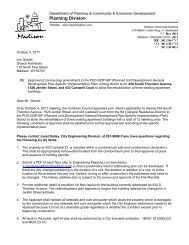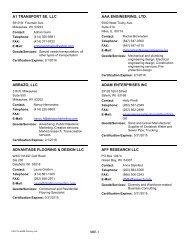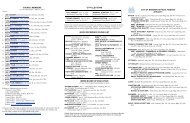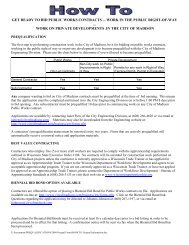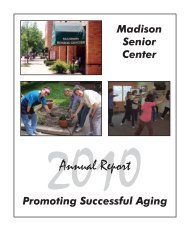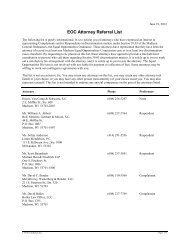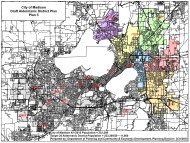Madison Cultural Plan 2011 - City of Madison, Wisconsin
Madison Cultural Plan 2011 - City of Madison, Wisconsin
Madison Cultural Plan 2011 - City of Madison, Wisconsin
You also want an ePaper? Increase the reach of your titles
YUMPU automatically turns print PDFs into web optimized ePapers that Google loves.
The city has<br />
outgrown its<br />
informal<br />
mechanisms <strong>of</strong><br />
engagement with<br />
the creative sector.<br />
<strong>Madison</strong> does not feature prominent links to comprehensive arts and cultural<br />
calendars and resource databases on either the municipal or Chamber <strong>of</strong><br />
Commerce websites. And while the Greater <strong>Madison</strong> Convention and Visitors<br />
Bureau does have an event listing, it is very limited in scope and not widely<br />
marketed locally. See Appendix E and Recommendation 8.<br />
III.A.2. MUNICIPAL PARTICIPATION IN THE CREATIVE SECTOR<br />
The <strong>City</strong> <strong>of</strong> <strong>Madison</strong> has major investments in cultural activities including the Public<br />
Library, the Overture Center, Olbrich Botanical Gardens, the, the Henry Vilas Zoo,<br />
the Public Art Program, the <strong>Madison</strong> Arts Commission, festival and special event<br />
services, and historic preservation and urban design functions. It also supports a<br />
number <strong>of</strong> closely related functions that include some arts and cultural content,<br />
including forestry, community gardens, Monona Terrace, the Senior Center,<br />
Warner Park Community Recreation Center, various neighborhood centers,<br />
certain special events, and the management <strong>of</strong> public grounds and facilities<br />
used occasionally for arts and cultural events. The city also regulates a number<br />
<strong>of</strong> aspects <strong>of</strong> creative sector businesses, especially those in the entertainment<br />
field and fairs, festivals and special events via licensing and permitting processes.<br />
As <strong>Madison</strong> has grown, so too have the city’s responsibilities for, and impact on,<br />
creative sector development.<br />
Presently, the city has no structure through which to focus its investments and<br />
efforts in the creative sector. While many solid working relationships between<br />
individual civil servants with responsibilities for creative affairs have been forged,<br />
examples <strong>of</strong> omissions, incompatible timelines, incompatible expectations, and<br />
lack <strong>of</strong> communication exist. Resource allocation, especially with regard to the role<br />
<strong>of</strong> the <strong>Madison</strong> Arts Commission in city-building, does not reflect workload burdens.<br />
The city has outgrown its current informal mechanisms for engagement with the<br />
creative sector.<br />
The <strong>City</strong> <strong>of</strong> <strong>Madison</strong> can strengthen its creative sector capacity and participation in<br />
three ways. First, it can broaden and strengthen the role and structure <strong>of</strong> the <strong>Madison</strong><br />
Arts Commission, positioning that body to take a leadership role in the city’s creative<br />
sector affairs. Second, it can work with the Finance Office to evaluate and enhance<br />
current capacity to identify and analyze municipal cultural expenditures. Third, it can<br />
create a staff team focused on creative sector planning. See Appendices A and B and<br />
Recommendations 1, 2, and 5.<br />
<strong>Madison</strong> <strong>Cultural</strong> <strong>Plan</strong> Findings<br />
28


